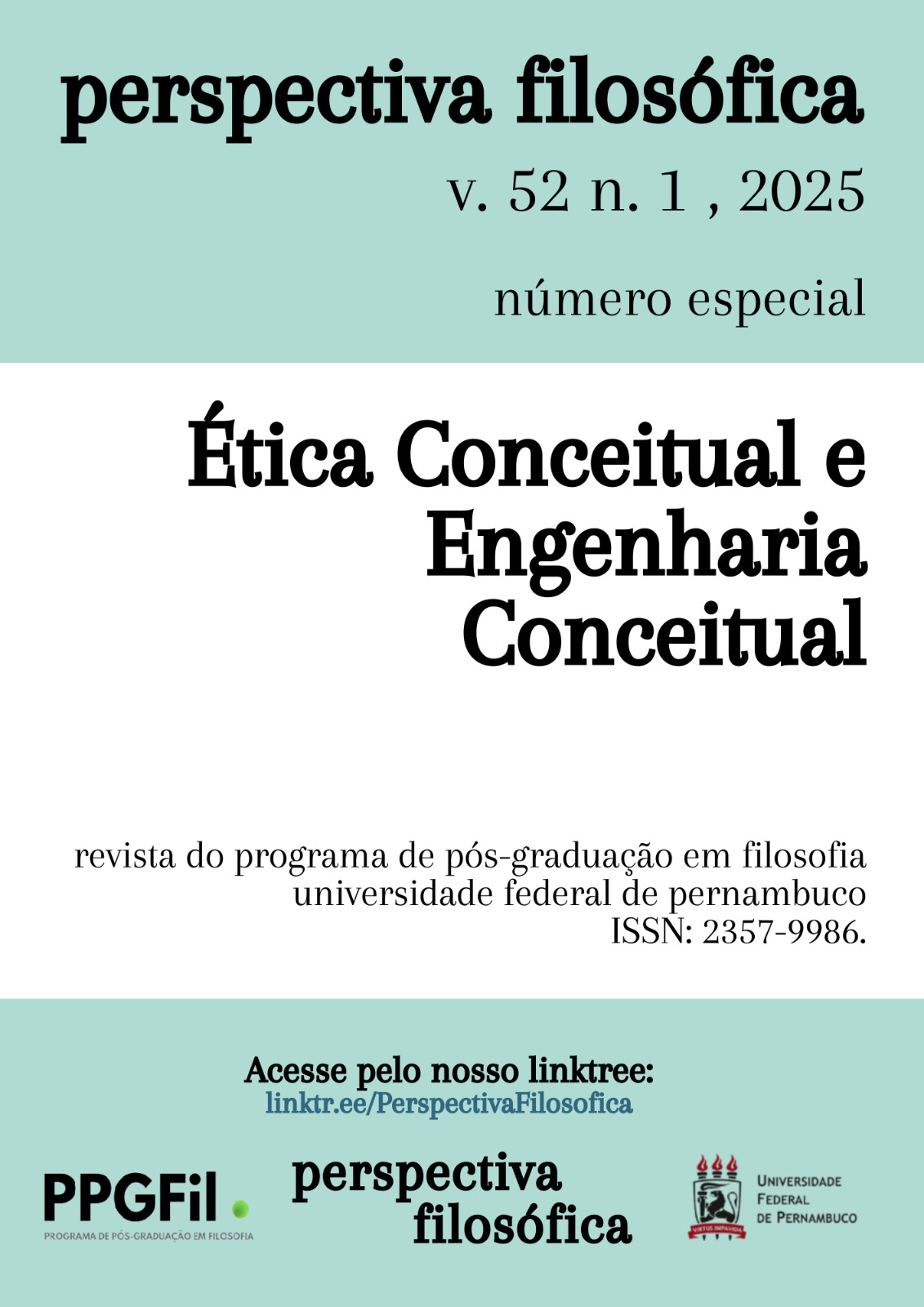Sameness of Subject Matter in Conceptual Amelioration
DOI:
https://doi.org/10.51359/2357-9986.2025.266965Keywords:
conceptual engineering, conceptual amelioration, sameness of subject matter, topic continuity, chains of meaningAbstract
Projects of conceptual engineering that aim to ameliorate concepts face the chal- lenge of topic continuity. In some instances of conceptual amelioration, a particularly strong kind of continuity is needed: Sameness of subject matter. This paper examines how sameness of subject matter can be maintained in conceptual ame- lioration. It starts from a view that sees concepts as ways of thinking, implying that to change a concept is to replace it. At first sight, this view seems incompatible with maintaining sameness of subject matter in conceptual amelioration. Accordingly, Sally Haslanger and Sarah Sawyer have suggested accounts of conceptual amelioration that do without replacing concepts. On their accounts, the persisting concept is supposed to guarantee sameness of subject matter. However, both ac- counts face problems. Therefore, I suggest a different account to maintain same- ness subject matter inspired by Bartels’s chains of meaning theory. On this ac- count, sameness of subject matter is guaranteed through a common referent of the pre- and the post-amelioration concept, established from the post-amelioration perspective. The account allows for sameness of subject matter even though concepts are replaced in the ameliorative process.
References
Ball, D. (2020a). Relativism, metasemantics, and the future. Inquiry 63(9–10), 1036– 1086.
Ball, D. (2020b). Revisionary Analysis without Meaning Change (Or, Could Women Be Analytically Oppressed?). In A. Burgess, H. Cappelen & D. Plunkett (Eds.), Conceptual Engineering and Conceptual Ethics (pp. 35–58). Oxford: Oxford University Press.
Bartels, A. (1994). Bedeutung und Begriffsgeschichte. Die Erzeugung wissenschaftlichen Verstehens. Paderborn: Schöningh.
Bartels, A. (2008). Die Konstruktion semantischer Kontinuität in der wissenschaftlichen Begriffsbildung. In E. Müller & F. Schmieder (Eds.), Begriffsgeschichte der Naturwissenschaften. Zur historischen und kulturellen Dimension naturwissen-schaftlicher Konzepte (pp. 223–239). Berlin: De Gruyter.
Blackburn, S. (2016). extension/intension. The Oxford Dictionary of Philosophy (3 ed.) (online)
Brun, G. (2016). Explication as a Method of Conceptual Re-engineering. Erkenntnis 81(6), 1211–1241.
Bunge, M. (1974). Treatise on Basic Philosophy, Vol. 1. Dordrecht: Reidel.
Cappelen, H. (2018). Fixing Language. An Essay on Conceptual Engineering. Oxford: Oxford University Press.
Evans, G. (1983). The Varieties of Reference. Oxford: Clarendon Press.
Glock, H.-J. (2009). Concepts: Where Subjectivism Goes Wrong. Philosophy 84(1), 5– 29.
Glock, H.-J. (2010). Concepts, Abilities, and Propositions. Grazer Philosophische Studien 81(1), 115–134.
Haslanger, S. (2000). Gender and Race: (What) Are They? (What) Do We Want Them To Be? Noûs 34(1), 115–134.
Haslanger, S. (2020a). Going On, Not in the Same Way. In A. Burgess, H. Cappelen & D. Plunkett (Eds.), Conceptual Engineering and Conceptual Ethics (pp. 230– 260). Oxford: Oxford University Press.
Haslanger, S. (2020b). How Not to Change the Subject. In Å. Wikforss & T. Marques (Eds.), Shifting Concepts. The Philosophy and Psychology of Conceptual Variability (pp. 235–259). Oxford: Oxford University Press.
Kant, I. (1998). Critique of Pure Reason (The Cambridge Edition of the Works of Immanuel Kant) (P. Guyer & A. Wood, Eds.). Cambridge: Cambridge University Press.
Kuhn, T. (1962). The Structure of Scientific Revolutions. Chicago: University of Chicago Press.
Ludlow, P. (2014). Living Words. Meaning Underdetermination and the Dynamic Lexicon. Oxford: Oxford University Press.
Margolis, E. & Laurence, S. (Eds.) (1999). Concepts: Core Readings. Cambridge, MA: MIT Press.
Nado, J. (2021). Conceptual Engineering, Truth, and Efficacy. Synthese 128(Suppl 7), S1507–S1527.
Peacocke, C. (1992). A Study of Concepts. Cambridge, MA: MIT Press.
Peacocke, C. (2005). Rationale and Maxims in the Study of Concepts. Noûs 39(1), 167– 178.
Prinzing, M. (2018). The Revisionist’s Rubric: Conceptual Engineering and the Discontinuity Objection. Inquiry 61(8), 854–880.
Putnam, H. (1975). The Meaning of ‘Meaning’. Minnesota Studies in the Philosophy of Science 7, 131–139.
Richard, M. (2019) Meanings as Species. Oxford: Oxford University Press.
Sainsbury, R. M. & Tye, M. (2012). Seven Puzzles of Thought and How to Solve Them: An Originalist Theory of Concepts. Oxford: Oxford University Press.
Strawson, P. (1999). Carnap’s Views on Constructed Systems versus Natural Languages in Analytic Philosophy. In P. A. Schilpp (Ed.), The Philosophy of Rudolf Carnap (pp. 503–518). LaSalle: Open Court.
Sawyer, S. (2018). The Importance of Concepts. Proceedings of the Aristotelian Society 118(2), 127–147.
Sawyer, S. (2020a). Talk and Thought. In A. Burgess, H. Cappelen & D. Plunkett (Eds.), Conceptual Engineering and Conceptual Ethics (pp. 379 – 395). Oxford: Oxford University Press.
Sawyer, S. (2020b). Truth and Objectivity in Conceptual Engineering. Inquiry 63(9–10), 1001–1022.
Yablo, S. (2008). Beyond Rigidification: The Importance of Being Really Actual. In Thoughts (pp. 171–190). Oxford: Oxford University Press.
Yalcin, S. (2018) “Belief as Question Sensitive.” Philosophy and Phenomenological Research 97(1), 23–47.
Downloads
Published
Issue
Section
License
Copyright (c) 2025 Cyrill Mamin

This work is licensed under a Creative Commons Attribution 4.0 International License.
A Revista Perspectiva Filosófica orienta seus procedimentos de gestão de artigos conforme as diretrizes básicas formuladas pelo Conselho Nacional de Desenvolvimento Científico e Tecnológico (CNPq). http://www.cnpq.br/web/guest/diretrizesAutores que publicam nesta revista concordam com os seguintes termos:
Os autores mantém os direitos autorais e concedem à revista o direito de primeira publicação, sendo o trabalho simultaneamente licenciado sob https://creativecommons.org/licenses/by/4.0/deed.pt_BR que permite o compartilhamento do trabalho com reconhecimento da autoria e publicação inicial nesta revista.
Os autores têm autorização para assumir contratos adicionais separadamente, para distribuição não-exclusiva da versão do trabalho publicada nesta revista, com reconhecimento de autoria e publicação inicial nesta revista (Consultar http://opcit.eprints.org/oacitation-biblio.html).

Esta revista está licenciada com uma Licença Creative Commons Atribuição 4.0 Internacional.













